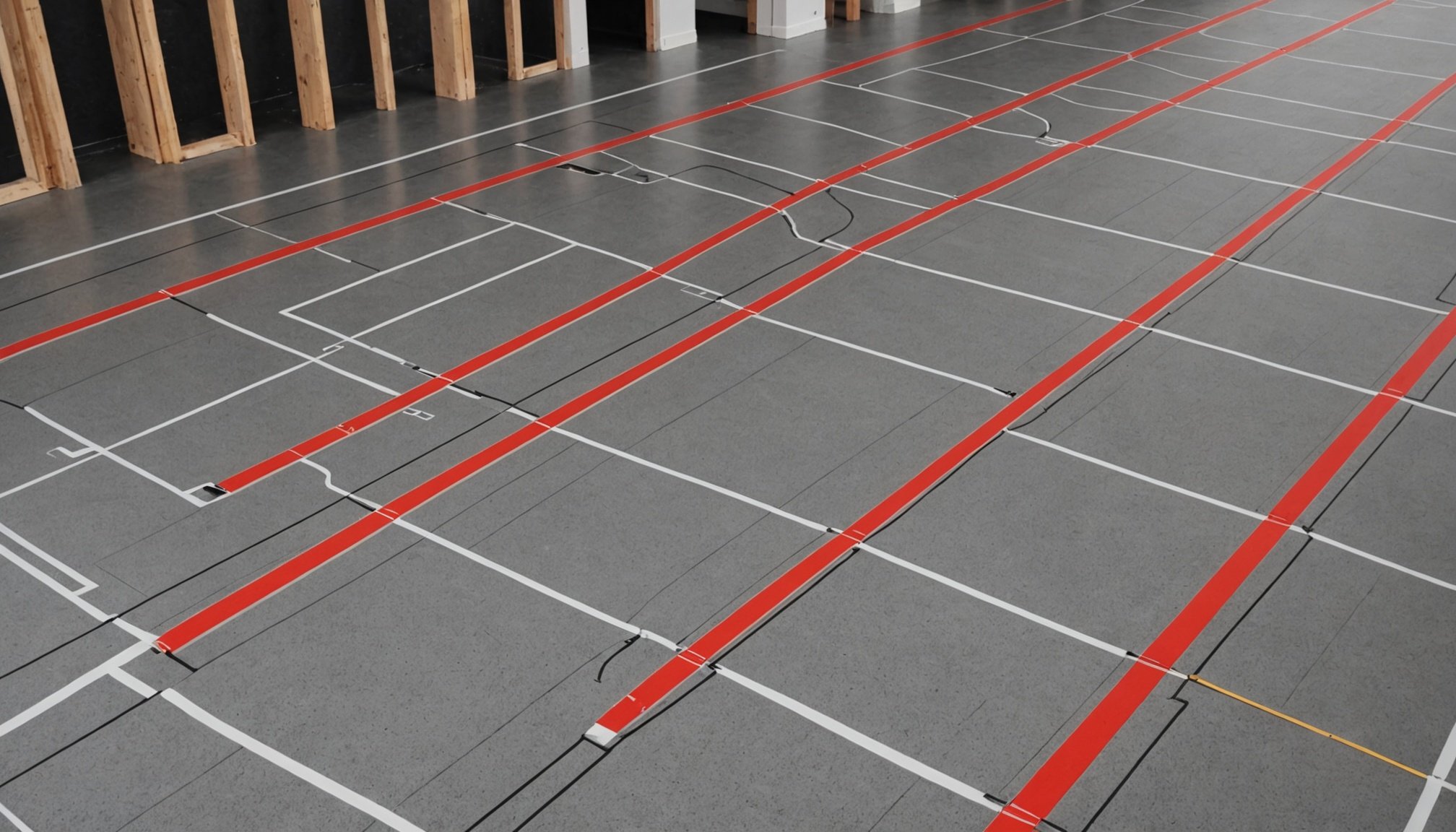Overview of Underfloor Heating in Concrete Surfaces
When it comes to modern home heating solutions, underfloor heating presents a compelling choice, especially for concrete surfaces. This system excels in distributing heat evenly, enhancing both comfort and energy efficiency. Unlike traditional radiators, which can create hot and cold spots, underfloor heating ensures a consistent temperature across the entire floor. Such heating efficiency is a result of radiant heat, which warms objects and surfaces directly, rather than just the air.
Concrete surfaces work particularly well with underfloor heating due to their excellent thermal conductivity. Once the concrete warms, it retains heat, providing a sustainable heating solution that can considerably reduce energy costs.
Also to discover : Illuminate your imagination: crafting your ideal home library bathed in natural light
There are primarily two types of underfloor heating systems to consider: electric and water-based (hydronic). Electric systems are easier to install and perfect for smaller areas, whereas hydronic systems are more complex but offer greater efficiency over large spaces.
Understanding the benefits and different types of systems can assist homeowners in making informed decisions about the best concrete surface installation for their space, ensuring optimal heating efficiency and comfort during colder months.
Also read : Designing an ideal noise-free environment for online teaching: mastering home distractions
Cost-effective Methods for Underfloor Heating Installation
Finding budget-friendly heating solutions does not have to be a challenge if you understand the balance between DIY installation and hiring professional services. For those seeking affordable installation techniques, opting for a DIY approach might seem appealing. It typically involves lower immediate costs and is suited for individuals with some technical know-how. However, it’s vital to consider the potential for mistakes, which could incur additional expenses later on.
Conversely, enlisting professional services ensures precise installation, minimising errors and often providing guarantees on work completed. This option provides peace of mind, particularly for large or complex installations, though it tends to be more expensive upfront.
Understanding the cost considerations for different heating systems is crucial. Electric underfloor heating systems usually have lower installation costs but can be more expensive in operation. Water-based (hydronic) systems, while having a higher initial outlay, can offer significant savings over time due to greater heating efficiency. Carefully weighing these options allows homeowners to make informed decisions that fit both their heating needs and budget.
Materials and Tools Required
A successful underfloor heating installation hinges on having the right installation materials and tools. Focusing first on the materials, it’s essential to select the appropriate types of heating mats and pipes. Electric heating mats are popular for ease of use and adaptability to various floor areas. For hydronic systems, durable pipes that can effectively conduct heat are critical. Additionally, adequate insulation underneath the system is key to improving heating efficiency; options like insulation boards or reflective foil help reduce heat loss.
Essential Materials for Installation
Securing the correct materials is vital. Consider these:
- Heating mats or pipes: Choose according to the system type (electric or hydronic).
- Insulation: Use boards or foil to maximize heat retention.
Tools Needed for Installation
The tools play an equally crucial role. Common tools include a tape measure for precision, a utility knife for cutting mats or pipes, and an adhesive spreader to ensure secure placement. Don’t overlook safety equipment; gloves protect hands from harsh materials, and goggles keep eyes safe from debris. Having these tools at your disposal ensures a smooth and safe installation process.
Step-by-Step Guide to Installation
A meticulous installation guide is pivotal for seamless underfloor heating systems. Begin with pre-installation planning by examining the concrete surface for cracks or imperfections and ensuring it is dust-free. Optimal surface preparation ensures the system’s longevity and efficiency.
Detailed Installation Steps
-
Layout Design: Design the heating layout using the room’s blueprint, tailoring it for comprehensive coverage.
-
Insulation Setup: Lay high-quality insulation material on the concrete to prevent heat loss, enhancing heating efficiency.
-
Position Heating Mats/Pipes: Install electric mats or hydronic pipes according to the chosen system, ensuring an even distribution across the area.
-
Connecting the System: For electric solutions, connect mats to a thermostat. For hydronic systems, link the pipes to a boiler or heat source, verifying connections for leaks.
-
Test the System: Upon setup completion, test the system to confirm uniform heat distribution and rule out potential malfunctions.
-
Seal with Flooring Material: Finalise by covering the system with suitable flooring material, guarding against damage while allowing radiant heat flow.
Following this structured approach ensures optimal functionality of your underfloor heating system within concrete surfaces.
Budgeting for Underfloor Heating
When planning for underfloor heating, comprehending the estimated costs is crucial for effective budgeting. The expenditure begins with materials and tools, with high-quality insulation and heating mats or pipes ranging from a few to several hundred pounds, depending on the system type. Labour costs can vary significantly based on whether you choose DIY installation or hire professionals.
Tools and labour form a significant budget portion. Essential tools often include a utility knife, adhesive spreader, and safety gear, totalling an additional investment. Hiring professionals, while more expensive initially, ensures precision and prevents costly errors. Labour fees can range, demanding careful planning.
To keep expenses feasible, consider these tips for sourcing affordable materials:
- Research multiple suppliers: Different suppliers offer varied prices for identical items.
- Utilize discounts and bulk deals: Look for seasonal discounts or bulk-buy deals on materials.
- Seek out refurbished or surplus items: These can provide functionality at a reduced price.
By strategically sourcing materials and tools, and understanding the heating solutions costs, you can adequately budget for a seamless installation. An informed approach ensures an efficient and cost-effective underfloor heating system.
Common Challenges and Safety Considerations
Installing underfloor heating in a concrete surface can offer notable heating efficiency, but it also presents several challenges. One major installation challenge is ensuring even heat distribution. Uneven heating can result from improperly laid mats or pipes, leading to cold spots. To overcome this, careful planning and adherence to the installation guide are crucial.
Another common issue is inadequate insulation, which affects system performance and increases energy costs. Ensuring proper insulation beneath the heating elements maximizes efficiency and prevents heat loss. Investing in high-quality insulation materials is advisable.
When it comes to safety precautions, working with electricity or water-based systems requires attention to detail. For electric systems, ensure wiring connections are secure to prevent hazards. In hydronic systems, rigorous pressure testing is necessary to detect leaks. Always wear appropriate safety equipment, such as gloves and goggles, to protect against potential injuries from tools and materials.
Before starting the installation process, verify the concrete surface’s integrity. Address any cracks or imperfections, as they can compromise the efficiency of the heating system or even cause damage. Ensuring a clean, even surface will contribute significantly to the success of your concrete surface installation.
Comparison of Traditional vs. Alternative Methods
When evaluating heating solutions, understanding the contrast between traditional heating methods and alternative heating solutions such as underfloor heating is pivotal. Traditional methods, like radiators, often lead to inefficient heating, creating uneven temperature distribution within a space. This inconsistency results in increased energy usage and costs over time.
Conversely, underfloor heating offers a seamless solution by providing uniform warmth across the entire floor, eliminating cold spots. The efficiency of this system mostly stems from its ability to heat spaces through radiant heat, which directly warms up objects and surfaces rather than relying solely on air temperatures.
When examining costs, traditional systems typically have lower initial installation expenses. However, the operating costs of underfloor heating, especially hydronic systems, tend to be lower over time due to their enhanced heating efficiency. Moreover, the long-term energy savings and increased comfort levels often justify the initial outlay for alternative systems.
From an environmental perspective, underfloor heating systems contribute to reduced energy consumption, aligning with sustainable living goals. By considering these aspects, homeowners can make informed decisions about their concrete surface installation, evaluating both cost-effectiveness and the enhanced comfort offered by alternative solutions.











